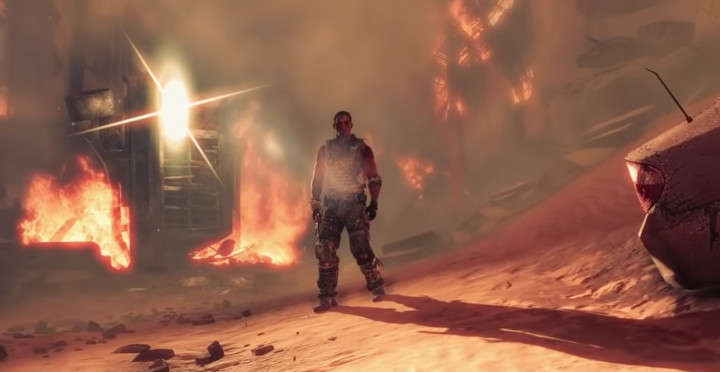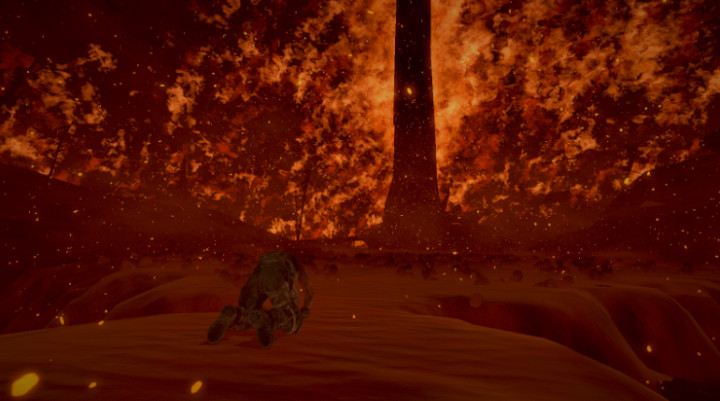
Before I ever published my first article about video games, Spec Ops: The Line was something I knew I’d have to talk about if I ever did start writing about games. It’s a genre-defying masterpiece that uses choice in some very interesting ways.
Before I get into it, though, I should warn you that there are heavy spoilers ahead. Also, this game has some grim content, so I want to mention right away that this article discusses content such as violence, war, PTSD, and psychosis.
I can’t stress this enough: Spec Ops: The Line is very dark. It’s a military shooter on the surface, but it’s actually a psychological horror game dressed up in shooter clothing.
If you feel comfortable proceeding, let’s move on. If not, feel free to check out some of the other great content on Half-Glass Gaming. I recently wrote a piece about The Legend of Zelda: Breath of the Wild, for instance.

In Spec Ops: The Line, you are following Captain Walker through a somewhat vague evac mission in Dubai. The “mission parameters” are always changing throughout the game, and you are often left to wonder what your mission is, exactly. That is on purpose.
The game takes the idea of “shoot first; think later” and turns it on its head. At first, you are fighting the locals, though not long into the game, you start fighting U.S. Soldiers. The basic idea is that a group of U.S. soldiers went rogue, and you are taking a stand against them. At some points, you are allied with the C.I.A. Toward the end of the game, you are allied with no one.
I was introduced to Spec Ops: The Line via Extra Credits, and they do an excellent job analyzing the game in a two-part video. If you’re interested, you can check out the first part here:
and the second part here:
Of course, my own experience is going to be biased from that introduction, as this breakdown very clearly influenced my perspective. I won’t try to deny that. Even so, I had my own perspective while studying this game. I actually helped write a group paper on Spec Ops: The Line at the end of a games journalism class in college, so this is a game I’ve spent a lot of time thinking about.
There’s so much I could cover here, but the element I want to focus on for this specific retrospective is how the game uses choice.
For instance, there’s a point in the game where you see two people hanging by their hands from ropes. You are asked to execute either a thief or a soldier who killed his family by shooting out the ropes from which they’re hanging. However, you can instead to kill neither and try to free them both. I’m not sure if it’s actually possible to free both, but the game reacts to that decision, and your crew will try to shoot out the ropes as well.
Here, the game presents what appears to be a simple A vs. B decision, but it allows you to make additional choices outside that decision tree. And even then, it’s not a matter of pressing a button but of acting out your choice via the game mechanics (shooting, for example) that you’re already familiar with. This adds a level of agency on your part, deepening the emotional impact of the scenario.
The choices you are asked to make start out simple and become darker and more difficult as the game progresses. In the first hostage scenario you’re presented with, you can let the hostage get killed, or you can try to save him, in which case he dies anyways. Later in the game, there’s an instance in which you can either take a shot to try to save a vital hostage while letting civilian hostages die, or you can try to save the civilians and watch him get killed. This choice is a little trickier.
It gets worse than that, though. Immediately after that last decision I mentioned is “the white phosphorus moment:” the only choice here is to use white phosphorus and kill everyone, including the civilians, or to just fight in one spot until you die. The game will not let you progress without using the white phosphorus.
Which brings us to the meta decision you’re forced into: the decision about whether you should keep playing knowing that you aren’t really the good guy anymore, or if you should just put the game down. By the end, you are told that you always could stop, but you didn’t. As a player, you kind of dissociate from Walker as he justifies his actions, while Walker also dissociates from reality. Walker’s dissociations are digetic, while your dissociations are meta.
You’re here because you wanted to feel like something you’re not: A hero.
John Konrad, Spec Ops: The Line
Throughout the game, Captain Walker is a devolving character who descends into madness as you are making increasingly harmful and destructive errors. Everything in Spec Ops: The Line works together to reinforce this.
For example, you and your crew become increasingly worn-down and unhealthy as you progress. This affects everything from character models to the way the characters talk to each other. In the beginning of the game, you and your squadmates act casual and light. They seem like a team of professionals who know what they’re doing. But as the game progresses, they will get more agitated and unhinged, even during gameplay. Their tones change. Each character sounds more distraught as the game goes on.
The enemies also evolve, though in quite the opposite way. It is fairly normal for enemies to become more difficult as the game goes on, but rarely is this tied to the plot in as cohesively as this. Enemies start out somewhat animated and over-the-top, screaming orders at each other, like, well, any military action game. But by the end, enemies are generally cold, distant, and professional. They increase in difficulty to the point where you are so overwhelmed that your last squadmate leaves you to “run” while he fights them off in a last-stand moment.

I’ve heard time and again that Spec Ops: The Line presents Dubai as more of a psychological landscape than a physical setting, and that’s true in a lot of ways. For one, you are in this city in the middle of the desert. This alone gives off a certain impression of isolation, as characters are always remarking on “being trapped in the storm wall,” and mentioning that there are “miles of desert” around.
The fact that it’s also in the Middle East — and that it’s Dubai specifically — also carries its own connotations. The U.S. military has a long history in this part of the world, and Dubai is a city representative of class power and foreign occupation through the immense high-dollar tourism market.
But there are a lot of psychological elements at play through the game’s level design as well. As pointed out in the Extra Credits video series, there is an absurd amount of descent in the game. You’ll be arbitrarily put at the top of buildings only to find yourself scaling or falling down them by the end. After the pivotal scene where you use white phosphorus, you are placed at the bottom of a hill, while the enemy shouts, “We have the high ground!”
There’s a particular banner hanging down one building with a face on it that seems to stare at your character throughout a level, no matter where you are. To me, that seems like a pretty close nod to the the eyes of Dr. T.J. Eckleburg from The Great Gatsby, a metaphor generally viewed as the eyes of God. What’s makes this really macabre is that you’re actually able to destroy this banner later in the game during a particularly grim rampage, in which you shoot down a building just to “see what this gun can do.” What that says, I don’t know.

And then there are the “heavies,” the tank-like enemies that appear throughout the game. On top of being difficult, their appearance coincides with trauma and stress.
Here’s what I mean: The first time you witness the use of white phosphorus at all, you are not controlling it, but you see the devastation it causes. As you walk through a recently glassed landscape, a heavy appears while Walker still seems to be in a somewhat disoriented state. Another heavy appears in a mall segment when Walker is alone in a hallway of flickering light. The heavy seems to teleport around, and when you shoot him, it appears you were just shooting a mannequin. The final heavy seems to be another hallucination — it happens to be your recently murdered crewmate Lugo saying, “You left me to die!” as he shoots at you. All you can do is shoot him or die.
All the while, the loading screens are trying to clue you in to what’s happening here. At first, they give you helpful hints, like “Lugo’s sniper training allows him to take out long-range enemies,” but they get darker as the game progresses. “Cognitive dissonance is an uncomfortable feeling caused by holding two conflicting ideas simultaneously.” By the end of the game, they are outright antagonistic: “Do you feel like a hero yet?” or “If Lugo were still alive, he would likely suffer from PTSD. So, really, he’s the lucky one.”
Jesus, Spec Ops…
The final choice of the game is the most impactful, and it’s entirely based on how you interpret the game’s message, your involvement in it, and Walker’s character. There are three endings, really.
- You can die, either by killing yourself, having Konrad kill you, or having troops kill you when they are there to save you. This suggests that maybe you are to blame, and the best way to end this is for your own character to die.
- You can kill Konrad and then be taken home by the military. When they say “How did you survive?” your character says “Who says I did? This suggests that your character would still rather place blame on the original man in charge of the occupation, a potentially imagined antagonist that Walker’s using as a scapegoat.
- Or you can fight the military, and tie it up by deciding that the only thing left in you or your character is murdering everyone.
Each of these endings is tragic in a different way, and they all say something different about the game, and something about you as a player.

Toward the beginning of this article, I mentioned that Spec Ops: The Line is ” a psychological horror game dressed up in shooter clothing.” Just about every design element reinforces this.
In a lot of situations, you have an easy first shot on the enemy, but when you hesitate to take that first shot, you may discover something. The “enemy” may be having a peaceful moment taking in the scenery only for you to kill them and get, well, basically nothing out of it. Even though you got a few stealth kills, the enemies usually will be alerted within a few minutes anyway.
There are several moments where civilians will just run in front of you, throwing into question the idea of mindlessly shooting everything in your way. I may be wrong about this, but I think there’s a firefight early in the game where you’ll inevitably end up shooting people from both sides.
There is also a finishing move called an execution, which allows you to melee kill a downed enemy. In the loading screens, text suggests that “some soldiers will get back up,” so you’re led to believe that executing them will stop this from happening. However, it seems like in most situations the “executable” enemies actually don’t get back up at all; they simply bleed out. But the game also gives you a violent blunt force attack to use on a dying enemy — the very act of giving you this choice is a way of goading you into it. You may not even question it until you’re deep in the game.
All that said, these choices don’t actually affect the plot much at all (aside from the ending). Rather, the set-piece choices are tests for the player. Choices are always offered, whether they’re apparent or not, simply to see how they sit with you. Seeing as Spec Ops: The Line is a cerebral exploration of the psyche, PTSD, and psychosis, this type of gameplay is perfect for the messages the game is trying to convey. It’s also a really interesting way to explore choice within a video-game narrative.
Taken altogether, the developers at Yager Development seemed to use everything in their arsenal to create an experience as cohesive as it is unique. They managed to make a game that is still very engaging, even when it seems to be shouting at you to put it down. This is a game that honestly seems like it hates you for playing it, but it’s also worth playing for its cohesive vision and extremely well-thought-out concept.
There really is nothing else like Spec Ops: The Line, which is part of what makes it so captivating for those who have played it. These are the types of games that really push the industry as an artistic medium rather than just mindless entertainment.
